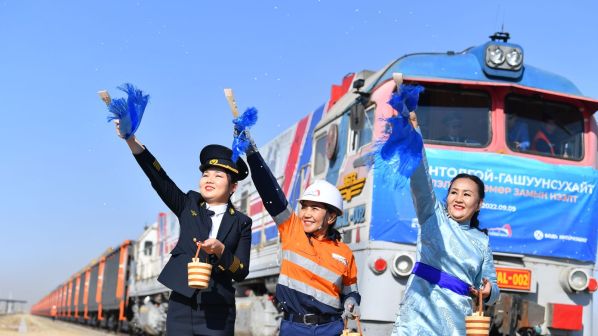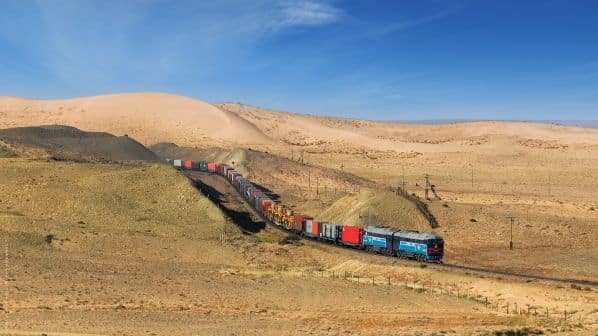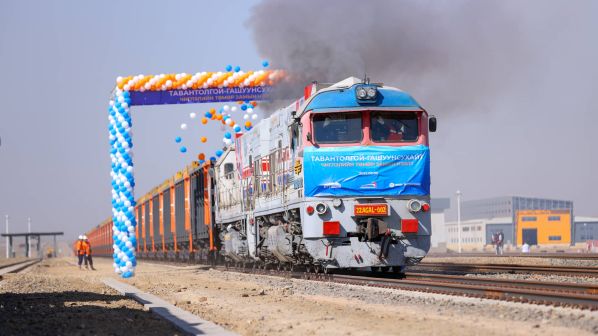A who’s who of Mongolian politics and society gathered at Tavantolgoi station, a distant outpost in the Gobi Desert, on September 9 to mark the official start of operation of the 258km Tavantolgoi - Gashuunsukhait railway.
The 1520mm-gauge line runs from the heart of one of the world’s largest untapped coking and thermal coal deposits to the border with China. Addressing more than 700 people who gathered for the ceremony, Mongolian president, Mr Ukhnaagiin Khurelsukh, described the new railway as “a road of development, investment and opportunity for Mongolia.”
Khurelsukh called for an extension of the Tavantolgoi - Gashuunsukhait line by around 30km to provide a direct connection to the Chinese standard-gauge network at Ganqimaodu. This would avoid the need for trucks to transport coal across the border; Mongolia signed an agreement with China to deliver this project alongside a long-term coal supply deal in June.
The president also urged the country to push ahead with completion of the Tavantolgoi - Zuunbayan and Zuunbayan - Khangi projects. Track laying on the 416km Tavantolgoi - Zuunbayan line is complete and a test train of 50 wagons carrying 3200 tonnes of copper concentrate travelled on the line in March. Reported issues with rolling out signalling are holding back commissioning, with some estimates putting March 2023 as a realistic opening date.
New railways are certainly welcome in these parts. Mining companies have relied on trucks to carry commodities, leading to inevitable inefficiencies, and leaving 6.4 billion tonnes of coal largely untapped.
The sudden boost in capacity is also timely given China’s current frosty relationship with Australia, traditionally its largest coal supplier, which led to the suspension of shipments from down under in December 2021. Mongolian coal producers sense an opportunity to feed China’s hunger for the fossil fuel, with new high-capacity infrastructure deemed critical to delivering on this potential.
Built to support 25-tonne axleloads, the Tavantolgoi - Gashuunsukhait line is expected to carry 30 million tonnes of coal per year in up to 12 trains per day, offering a journey time of around four hours. It is already producing dividends: cross-border shipments by truck have increased from an average of 560 per day in August to around 690 per day since the railway opened, according to a report by China Coal Resources. The cost of transporting coal from the Tavantolgoi mine to the Ganqimaodu port in China has reportedly fallen from $US 47 to $US 12 per tonne. Tests have also taken place at Ganqimaodu to handle up to 900 trucks per day, hinting at future growth; Khurelsukh says he expects revenue from coal exports to double.
Access and ownership
Struggles over access and ownership of Mongolia’s natural resources have defined much of the country’s foreign policy since the break-up of the Soviet Union. It is a symptom of democratic Mongolia’s position between China to the east and Russia to the north, both of which, to varying degrees, have put pressure on Ulaanbaatar to provide access to mines over the past decade or so.
Construction on the Tavantolgoi - Gashuunsukhait line started as long ago as 2012, with civil works reaching 85% completion by late 2014 when work came to a grinding halt.
Protracted disputes over the preferred gauge had divided government since the announcement by parliament of the State Policy on Railway Transport (Railway Policy) to build new railway infrastructure throughout the country’s mineral-rich regions.
Struggles over access and ownership of Mongolia’s natural resources have defined much of the country’s foreign policy since the break-up of the Soviet Union.
Studies by The Boston Consulting Group (BCG) in 2009 identified the potential to construct a 5600km railway network. This would follow the southern band of natural resource deposits, from Choybalsan, the terminus of the cross-border line from Solov’yevsk-Ereentsay in the northeast, via Sainshand and Dalandzadgad in the south to Ulaangom and Tsaganoor on the Russian border in the northwest.
The Railway Policy was initiated under the stewardship of Mr Khaltmaagiin Battulga, who served as minister of roads, transport, construction and urban development from 2008 to 2012. Battulga was a strong proponent of adopting 1520mm gauge as well as a vocal critic of China’s influence in Mongolia.

BCG, working from its Moscow office, shared a preference for the use of 1520mm gauge to integrate with the existing north-south railway, which runs for 1815km from the border with Russia at Subataar to Zamli-Uud on the Chinese border, and was built between 1947 and 1952. The study recommended building new infrastructure in three phases. The first focused on delivering the west-east corridor, from Dalandzadgad to Sainshane, Khuut and Choibalsan. The cross-border links were included in phase 2 while phase 3 focused on developments in the west of the country and was considered a long-term objective.
The Railway Policy was approved by the Mongolian parliament in March 2010.
This decision effectively made an earlier concession agreement with Mongolian Mining Corporation (MMC), which is listed on the Hong Kong stock exchange, to build the Tavantolgoi - Gashuunsukhait line to standard gauge as null and void.
A subsequent study of the business case for network expansion, conducted by McKinsey and published in August 2011, outlined financial and technical parameters for delivering the railway programme. It recommended construction for 25-tonne axle loads over 32 tonnes and the use of diesel traction. The report estimated the combined cost of phases 1-2 at $US 5.1bn for both infrastructure construction ($US 4.5bn at $US 2.5m per km) and above rail assets ($US 678m) for the full 5600km network, including the purchase of around 125 locomotives and 3900 wagons. It stated that the decision to use some standard or entirely broad gauge for the lines was at the discretion of the government.
The goal of the study, according to Mr Ganbat Chuluunkhu, whose firm Liberty Partners worked as a local advisor during various stages of the project between 2010 and 2014, was to present conditions demonstrating the financial stability necessary to secure international finance. He says Mongolia’s autonomy from Russia and China was critical in this, albeit with the economy heavily dependent on exports to China: China receives around 90% of Mongolia’s total exports and 70% of this is coal.
American companies, financial institutions and law firms were heavily involved in these processes. “Our team was working as the local advisors on all levels of the project,” Chuluunkhu says. “We supported McKinsey in their work and worked as financial advisors on the Railway Project, providing guidance for the selection of Bechtel and Flour to develop the masterplan for the industrial park at Sainshand.”
Liberty also worked alongside BNP Paribas and Guggenheim International, which provided financial advice for the Railway Project, and with Sidley Austin and MDS Associate to provide legal support. German Rail (DB) worked as an owner’s engineer for the project’s sponsor, Mongolian Railways (MTZ), with the Tavantolgoi - Gashuunsukhait, or South Line project, although a phase 2 scheme, identified as the primary line for generating revenue and became the target for development and financing.
This was duly delivered through a $US 1.5bn sovereign debut bond secured in November 2011, with markets responding favourably to the country’s plans to further the downstream process and to diversify its customer base.
The South Line received proposals for $US 650m of debt financing, which was secured as a syndicated commercial loan tranche from international commercial banks with an export credit guarantee from Korea Eximbank and the European Bank for Reconstruction and Development. The Mongolian government provided the remaining $US 400m as equity. Additional funding was set aside to develop the Sainshand industrial complex. Located at the connection between the north-south and future east-west railway, the goal was to develop the site into a future logistics and industrial hub for value-added production of iron ore and coking coal.
MTZ was established in 2008 and was charged with delivering the Railway Project, activating a grandfather clause with Samsung C&T, Korea, at the request of MMC to avoid penalties, for a $US 483m engineering, procurement and construction contract for the South Line in May 2013. Work commenced shortly afterwards.
Nevertheless, pro-Chinese factions within Mongolia, favourable to building the line to standard gauge, continued to lobby for the rejection of the 1520mm-gauge plan. Russia was also working in the background to further its own interests.
Russian access
Russian Railways’ (RZD) then president, Dr Vladimir Yakunin, had a keen desire to retain 1520mm gauge for railway projects in Tavantolgoi. RZD holds a 50% stake in Ulaanbaatar Railway (UBTZ), which operates and maintains the north-south railway, and Yakunin was said to be particularly interested in Russia accessing coal deposits via the line.
This idea was firmly rejected by Battulga and MTZ was deliberately chosen to oversee the New Railway plan to counter this Russian interest. Russia’s influence even led to the rejection of $US 188m in grant funding from the US to support upgrade work on the UBTZ line.
By 2014, Battugla was in opposition. And while still attempting to influence thinking on the railway programme and the perceived threat of China, the Mongolian government approved a plan to build two standard-gauge lines to China in October 2014: the Tavantolgoi - Gashuunsukhait and Khuut - Bichtig routes. The government confirmed that the Tavantolgoi - Sainshand - Khuut - Choybalsan and Khuut - Numrug lines would remain 1520mm gauge.

The decision was expected to reduce the cost of cross-border coal transport from $US 6 a tonne to $US 4 and was widely praised by investors on the other side of the border. Yet the project was already running into trouble. Mongolian authorities under president, Mr Tsakhiagiin Elbegdorj, and prime minister, Mr Chimed Saikhanbileg, had commenced investigations of Samsung C&T executives in Mongolia and individuals from BNP Paribas and McKinsey, as well as close associates of Battulga involved in the project, accusing them of corruption.
The move effectively brought construction to a standstill, provoking frustration among the general press and country, with authorities regularly accused of spending $US 200m to move some dirt in the desert.
Press releases published on MTZ’s website in the months and years after work stopped reveal a desire to revive the project and to secure the necessary funding. And while MTZ and various transport ministers were keen to stress that the foundation for a new railway was sound, meetings with China’s Asian Infrastructure Investment Bank and countless roadshows to promote the project and secure finance proved fruitless.
It wasn’t until Battulga, riding a wave of anti-Chinese sentiment, was elected president in 2017 that the railway programme was restored, inevitably with the focus returning to 1520mm gauge. Battulga reassembled the Mongolian National Army’s Civil Engineer Corps as a cheap means of continuing construction with the entire project funded by the Central Bank of Mongolia through a local bond issuance at a reduced overall cost.
Although no western consultants were involved at this point, their earlier efforts provided the foundation for work to resume. Tavantolgoi Railway was founded in August 2018 with specific responsibility to oversee delivery and operation of the Tavantolgoi - Gashuunsukhait line. The company is owned by Erdenes Tavantolgoi (66%) and MTZ (34%).
Bodi Construction, Mongolia, was subsequently contracted to manage construction of the railway, working alongside 62 subcontractors. Work included constructing two stations on the line and 16 bridges, including a 430m-long span that is the longest in Mongolia. In addition, Bodi agreed to purchase 16 EMD SD70ACeLW diesel locomotives under a contract signed with Progress Rail in March 2021. United Wagon Company, Russia, has provided 810 type 12-9853 gondola wagons for coal transport.
As well as the railway, work on building the railway terminal at Gashuunsukhait also concluded in June, the 70ha site hinting at the potential for a future transfer facility at the break of gauge.
Elsewhere, work is taking place on the wider Railway Project, which was estimated to cost $US 8-9bn by MTZ in 2019. Construction of the 416km Tavantolgoi - Zuunbayan section of the Tavantolgoi - Sainshand - Khuut - Choybalsan line commenced in May 2019, following front-end engineering design work conducted by Nippon Koei, Japan, and again largely carried out by the Army Civil Engineering Corps. Work on the 226km Zuunbayan - Khangi branch also began earlier this year. This line will provide another cross-border link to China and MTZ confirmed that it began track laying on a 100km section in September.
Construction is similarly underway on the 43.5km Nariinsukhait - Shiveekhuren line and a 22km link to connect the Tavantolgoi - Gashuunsukhait line north to the Tavantolgoi - Zuunbayan line. This will provide a direct connection from the Southern Line to the wider Mongolian network.
A further 380km line from Khuut to Numrug is planned, while MTZ is seeking private investors for a design-build-operate-transfer public-private partnership to build the 415km Choybalsan - Khuut - Bichigt line, hosting a launch ceremony for the scheme in July. The railway is estimated to have an annual capacity of 25 million tonnes.
Exports to the east
The desire to invest in this project is likely to be strong in Russia, but not for the same reasons as 10 years or so ago.
The war in Ukraine has led Moscow to double down on efforts to boost exports to the east. To meet demand RZD has expressed the need to increase capacity on its railways in the region, which have traditionally suffered from constraints.
There are currently three direct cross-border crossings between Russia and China, all of which are east of Mongolia: at Zabaikalsk-Manchuria, Blagoveshchenskiy-Heihe, and Khasan-Suifehne for trains to Vladivostok.
RZD confirmed at the Eurasian Economic Forum (EEF) in Vladivostok in early September that it is exploring two additional border crossings, one east of the line to Zabaikalsk via Priargunsk, to provide direct access to the Chinese provinces of Inner Mongolia and Heilongjiang. This would require China to build a 192km line to connect the border crossing to the wider network. The second is the line at Solovyovsk-Erentsav, which would require completion of the Choybalsan - Khuut - Bichtig line to provide transit to China.
Boosting capacity on the UBTZ line through Mongolia is another option, especially as it will offer much faster transit times than the eastern border crossings. Russia committed to such a programme in 2019 after the two countries reached an agreement in 2018 to offer a 66.4% discount on the cost of transporting Mongolian sourced freight to and via Russia for 25 years.
In a meeting with Mongolian prime minister, Mr Luvsannamsrain Oyun-Erdene, at EEF, RZD president, Mr Oleg Belozerov, emphasised RZD’s desire to increase capacity at Zamyn-Uud, including the possibility of introducing double track.
Trade between Russia and China increased by 29% in the first seven months of this year. This trend looks set to continue, particularly with no end in sight to the conflict in Ukraine and relations between Russia and the west at their lowest ebb for many decades. It therefore appears a matter of when, not if, investment will come to Mongolia. The country’s railway is once again poised to play a major role in its own immediate geopolitical futures and that of its two powerful neighbours.
Northern Railways Corridor plans stall
THE Mongolian government issued a 30-year concession to Northern Railways in 2015 to develop the 547km Erdenet - Ovoot railway. The line will provide a connection to Aspire Mining’s planned Ovoot coking coal mine as well as the planned 238.6km Ovoot - Arts Suuri railway and a future cross-border connection from Arts Suuri to Kyzyl and the Trans-Siberian Railway.
Northern Railways is owned by Aspire Mining (80%) and Noble Group (20%) and the parties entered into an agreement with China Gezhouba Group International (CGGC) in 2017 to complete a definitive feasibility study for the Erdenet - Ovoot project. The railway could carry up to 10 million tonnes per annum (mtpa) when activated.
The study was due to be completed in 2018 but little progress has been reported since then. As Mr David Paull, chairman of Aspire Mining, revealed to IRJ, the government sought to change the route in 2019, and this situation has yet to be resolved. Since then, Paull says Aspire has focused on establishing a smaller mining operation served by a road connection to Erdenet.
A proposed extension from Ovoot to Arts Suuri is ultimately dependent on completion of the Erdenet - Ovoot project. Northern Railways reported receiving a preliminary economic assessment for the $US 580m project in October 2018, which would have capacity for 15mtpa.
Political disputes between the Mongolian government and private mining companies are credited for stifling private investment elsewhere in the country. However, after the government reached a resolution with Rio Tinto, a minority shareholder with the government in the Toutolgoi copper-gold project to commence underground operation in January 2022, Aspire was reported as describing this as a watershed moment for foreign investment in Mongolia.

